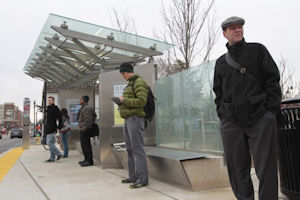One million dollars for a new bus stop in Arlington County? No wonder so many people regard mass transit as a boondoggle. “Is this made of gold?” the Washington Post quotes one commuter as asking.
No, actually, the bus stop near Columbia Pike and Walter Reed Drive, is made mainly of concrete and glass. It does have heating elements embedded in the floor as well as an electronic route-viewing map, but the roof won’t provide much shelter if the wind blows in the wrong direction. The bus stop, designed to shelter up to 15 people at a time, is the first of 24 that will accommodate both buses and Arlington’s long-planned street cars.
Actual construction and fabrication for this stop cost $575,000, while another $440,000 went to construction management and inspections. “When you do a prototype, you end up heavily front-loading on the costs,” explained Dennis Leach, Arlington’s transportation director. “These are more like high-capacity bus or rail stops.” Still, according to the Post, the county has budgeted an average of $900,000 for the other 23 stops.
Bacon’s bottom line. Wow! It’s hard to imagine how even a large bus stop — one that provides decent protection from the elements — could cost more than $100,000. For $900,000 each, these things should be gold plated!
It is imperative that Virginia’s metropolitan regions expand their mass transit services to provide mobility and access for a population that increasingly finds automobiles an unattractive or unaffordable transportation option. But mass transit systems also must be fiscally sustainable. Most local governments will remain under severe fiscal stress for years to come and the federal government will not long be able to continue subsidizing the up-front capital costs. (Arlington hopes Uncle Sam will chip in 30% of the $250 million cost of the street car project.)
Riders of the 37-year-old Washington Metro rail system have discovered in recent years that mass transit infrastructure wears out eventually and must be replaced. Metro officials have no idea where the hundreds of millions of dollars will come from. Local governments need to account for the full life-cycle costs of their transportation systems on an ongoing basis, which means replacing rail cars, buses, escalators and bus stops without federal money when they wear out.
As e-mail correspondent Christian Waller points out, the commonwealth of Virginia legislatively requires condominium associations to accumulate replacement reserves for all capital improvements. “If our governments followed their own such legislation,” he writes, “we wouldn’t have such a dire long-term fiscal outlook regarding transportation, utility and other infrastructure.” And local governments would be more careful about what they built in the first place.
Arlington officials have done such a brilliant job fostering cost-effective development — the street cars will support higher-density development along Columbia Pike — that the county probably can afford to support this extravagance. But that’s really no excuse. As long as mass transit is underwritten by taxpayers, who may or may not use the system, the county needs to be more attentive to costs.
Hat tip: Ron Utt
— JAB



